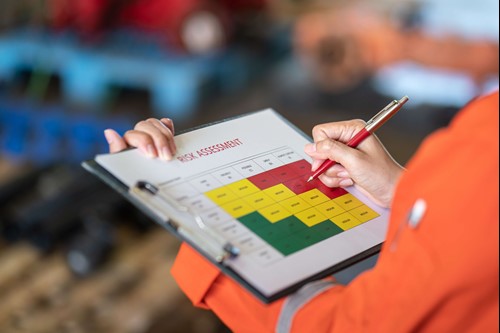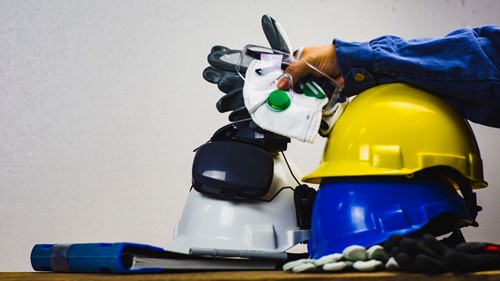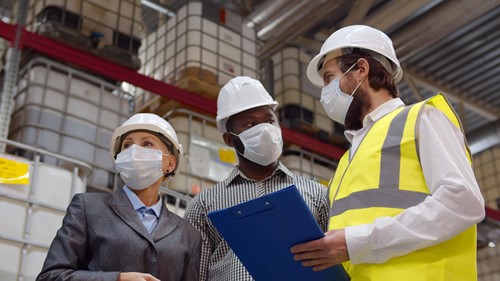The health and safety of your employees should be at the top of your list of priorities. Creating a health and safety checklist will help to ensure that you've covered all your bases.
These checklists work with your health and safety policy, to improve compliance with your workplace health and safety practices. This helps to ensure that everyone on your premises follows the correct safety procedure.
Need help putting together your own safety checklist templates, health and safety checklist, and policy? Why not get in touch with one of our experts here.

What is a health and safety checklist?
A health and safety checklist is used to improve workplace health and safety practices (WHS).
This helps your business ensure you are compliant with any safety regulations. Utilising health and safety checklists help employers like you carry out regular inspections to help mitigate the risk of incidents, injuries and illnesses happening in your workplace.
What are the elements of safety?
Businesses should implement a behaviour-based program in their workplace to help promote a safer working environment. Creating a safety culture goes further than a health and safety checklist. Fundamentally, business owners need to align attitudes, beliefs and values around safety in your organisation.
If each of your employees is able to promote their own health and safety attitudes at work, it will encourage others to do the same.
Leadership
Employers and team leaders should lead by example. If your employees can see their managers following the correct health and safety procedures and policies then they will be more willing to follow them themselves.
Employers should also ensure that everyone in their business has received health and safety training. This ensures that your staff know the emergency procedures and what they should do if an incident occurs.
Responsibility
Everyone in your business should feel some level of responsibility towards the health and safety of those around them.
This could be ensuring they are following the correct procedure themselves, or reporting to their manager if there is an issue with the current procedure. For example, if a piece of electrical equipment or personal protective equipment is broken or no longer fit for purpose.
Accountability
Team leaders should be accountable for the team members that they manage. As an employer, you should ensure that they are receiving regular refresher training in health and safety.
Team leaders should report to the safety executive or competent person, any risks that present themselves so an adequate risk assessment and safety checks can be carried out.

Health and Safety Checklist
All businesses should have a health and safety checklist template, these will help you to identify the risks within your business and assess the procedures that you've put in place.
There are many steps you can take to improve health and safety awareness, competence and delivery in your business. These include:
Step 1: Create a health and safety policy
The first step you should take is to create a comprehensive health and safety policy. If your business has over five employees, then you are required by safety law (Health and Safety at Work Act 1974) to have a policy in place.
Your policy will outline your health and safety procedures, and what employees must do in the event of an incident or accident.
This could include, who it is that your employees need to inform if something happens:
- Who the responsible person is.
- How the procedures are carried out.
Step 2: Assign someone the role of managing health and safety
After implementing a solid health and safety policy, business owners should look into appointing someone to manage their health and safety, this can sometimes be referred to as the 'competent person' or 'responsible person'.
The appointed person will be responsible for ensuring that your policy is being followed correctly; carrying out risk assessments when needed and keeping them up to date; first aid, and ensuring that your business stays legally compliant.
They may also be responsible for ensuring that your employees are up to date on their training, and will provide training and offer additional training if employees require it.
Step 3: Produce risk assessments for the necessary risk to workers
You need to think about the risks that are associated with your business and with what your team is doing day to day. Completing a risk assessment will identify hazards and risks, and you can then put in control measures to keep your employees, visitors to your premises and customers safe.
Risk assessments could cover small activities, such as tripping over cabling or uneven floors. Likewise, the assess long-term activities, such as looking at computer screens for prolonged periods of time (DSE).
A well-produced risk assessment will then go on to say what you have done to mitigate risks, such as using cable guards, signs to warn of uneven flooring or implementing regular breaks. These are important as they show that you are remaining compliant with health and safety laws.
Step 4: Talk to employees about the protective action
Once risk assessments have been completed, you must inform your employees of the results, and what the protective measures you've put in place are. This is where you will tell your employees how it will affect how they carry out jobs, for example, if there is a new piece of protective equipment they need to use or wear.
At this stage, you should also talk to your employees about the consequences of not following your health and safety procedures. For example, if employees are doing a lot of heavy lifting, informing them that if they don't lift the item in the correct way it could be damaging to their physical health.

Step 5: Display the health and safety 'What you need to know poster'
Hanging health and safety posters around the workplace is a brilliant way of informing staff of your health and safety procedures.
They can be tailored made for specific parts of the workplace that relate to the task nearest them. These can be used in the kitchen or canteen area to demonstrate what employees should do if they accidentally burn themselves.
Additionally, they can be used in areas where employees are likely to be taking part in heavy lifting to remind them of the correct way to lift a heavy item.
Step 6: Make sure you report RIDDOR reportable incidents
If an incident occurs you may need to report the incident to RIDDOR, while we all hope that never happens, it can. Failing to report such incidents can lead to a custodial prison sentence of up to two years (for the employer or responsible person) and an unlimited fine.
These are normally filled out by either the employer or whoever the competent person is.
Step 7: Monitor and improve procedures.
Last but by no means least, once you've put procedures in place, you need to ensure that they are constantly checked. By carrying out regular inspections, employers can check that the procedures are fit for purpose and work.
This includes regularly checking PPE equipment and ensuring it's not damaged.

Speak to an expert
Health and safety can be a minefield to get right, so why not speak to the experts? We're here to help you ensure that your staff and anyone visiting your premises are staying safe and that any risks have been mitigated.
Croner has a team of award-winning HR consultants who are specialists in their field. We've been helping businesses for over 80 years and our advice line is open 365 days a year, 24 hours a day. Why not speak to a Croner expert on 0800 470 2818.
Categories
- Business Advice
- Contracts & Documentation
- Culture & Performance
- Disciplinary & Grievances
- Dismissals & Conduct
- Employee Conduct
- Employment Law
- End of Contract
- Equality & Discrimination
- Health & Safety
- Hiring & Managing
- Leave & Absence
- Managing Health & Safety
- Moving
- Occupational Health
- Pay & Benefits
- Recruitment
- Risk & Welfare
